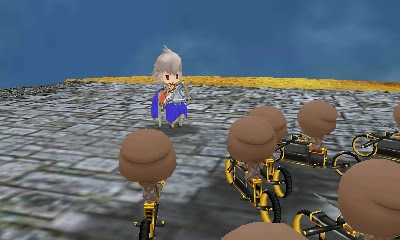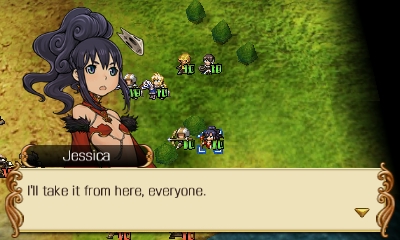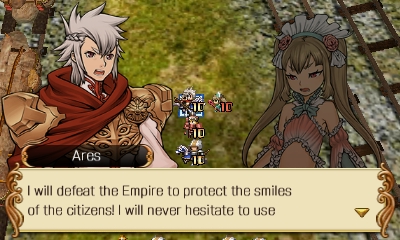Review by Matt S.
I’m pretty sure that I’m meant to deeply dislike Langrisser Re:Incarnation -TENSEI-. Virtually everything that I’ve seen about the game has been negative, every time I’ve seen it mentioned on Twitter has been in a context that is… less than complimentary, and those screenshots aren’t exactly glowing.
Related reading: This game is very much in the vein of Fire Emblem. Matt’s review of one of the Fire Emblem games on the 3DS here.
And the initial impressions of the game certainly don’t help. There’s a hopelessly derivative start in which an evil empire invades a nation (because we’ve never heard that one before), displacing a small band of heroes, one of whom happens to be carrying a holy sword, and that force ends up fighting for the army of light. It’s actually a plot hook we’ve seen in one form or another across so many Fire Emblem games, but in this case, the storytelling is only about as developed as what we saw in the very first, primitive, Fire Emblem. Character dialogue is simply painful in places too, and I had very little interest in any of the characters, which is a stark contrast to the Fire Emblem games, where I’m in love with them almost immediately. Lyn’s one of my favourite characters of all time, for example, and I loved her from the moment she slashed up one of those axe-wielding meat-heads, right at the start of her 30-hour-odd quest in Fire Emblem on the Game Boy Advance.
I am comparing Langrisser to Fire Emblem for a very simple reason; the game plays out very much like a Fire Emblem game – especially in the early stages before the more unique features (which I’ll get to in a moment) can cut in. There’s a similar tactical map of each battle site, and then, each time units duke it out, there’s a similar zoomed-in effect so players can watch each battle play out dramatically.
The biggest problem with Langrisser – and probably the reason it has such a poor reputation when we break it down – is that, while the overmap looks about as pleasant as you’d expect for a tactics game, the actual combat “cut scenes,” are intensely ugly, as bobble-headed characters run at each other, then stand still for a moment, go through an attack animation (that, like with Pokemon battles, doesn’t actually connect with the opponent), and then some of them fall over, “dead”. Actually, “ugly” is being generous; it’s aesthetically broken stuff, and each attack is accompanied by an embarrassing “war cry” that sounds more like the voice actors got really, really drunk, and started growling at one another.
Oh, and I would be remiss if I didn’t say this, because it will probably upset some who see the screenshots and expect something relatively clean like a proper Fire Emblem title: in Langrisser there are a bunch of children characters that are wearing less material than you’ll see in a typical Victoria’s Secret show. I’m not talking about characters like Dead or Alive’s Marie Rose who are nudge nudge, wink wink, satires of the whole Lolita thing. I’m talking actual children whose bodies have barely started developing. Does it offend me? No, not really, because the art is simply too low resolution and cheap to start to push my sensibilities, but at the same time there’s no real context to explain why the characters would be dressed this way, other than the fact that all the adult female characters are dressed provocatively, so the child ones must follow suit, and it all comes across as quite unnecessary and exploitative. If there was a reason for the costuming, then that’s one thing, but we’re not talking about a Shakespearian philosophical treatise here, and coupling the costuming with the under-baked dialogue and narration leaves a very juvenile impression over the first couple of hours.
But – and yes, there’s a significant but here – as I got deeper into the game, I ended up really enjoying myself. By the tenth hour my opinion of the game had completely backflipped. The storytelling doesn’t really get better, but Langrisser’s strict adherence with tradition starts to become quite charming in its own, odd way, the costuming fades into the background thanks to the character design being so uninvolving, and then the game has quite a few neat little ideas that help to distinguish it from Fire Emblem. By the tenth hour I was finding it difficult to put the game down.
One of the features I really liked was the ability for each hero to recruit mercenaries to help them out in a fight. Mercenaries behave as separate units, and thus significantly bolster the size of the fighting force. By themselves they’re quite weak, but when supported by the hero units working in close formation, they can really start to roll over the enemy.
And heroes do have to work quite closely together. Each hero has the potential to significantly boost the offensive and defensive characteristics of the other heroes close by to him or her, and in overcoming some of the enemy units, these boosts are the difference between success and failure. This does slow down the pace of the game somewhat, as you’ll be turtling parties in blocks so you can maintain those support benefits, but once the whole army is moving in unison, it sure does feel good to roll over the enemy forces like an avalanche.
Langrisser also starts to try and introduce deeper themes later on; let down somewhat by the clunky storytelling, but nonetheless earnest. Periodically you’re given difficult choices to make, and the decisions that you make determine how the plot pans out (and, given this game is significantly lengthy in each play through, gives you an awful lot to come back to). Hints of moral philosophy come through too, when one of the enemy casually mentions that from their perspective the heroes of light are the evil, running through the countryside and killing by the dozen as they are. Moral relativism is not a theme I ever expected to come across in this game at the start, and yet there it is. Langrisser is clearly the work of a team constrained by budget and time, but the intentions of it are quite noble.
I’m not going to say that the visual impact of the game ever improves, because it doesn’t, but what Langrisser does do really well is its level design, which offers large maps with some interesting layouts to work around. Scenarios are also quite interesting, and battles that have time limits and the like help to keep you from playing too cautiously. The range of units is good too, and there’s some limited control over how each unit develops, which helps to give you a sense of ownership in your forces. Thanks to that variety, Langrisser is surprisingly deep on the tactical level. As with Fire Emblem you’re not going to be able to bring in all your units for each battle, so you’ll need to pick carefully to ensure the mix is strong. And you’ll need to care for your units, too. Resources with which to hire mercenaries are limited, and while you earn plenty of cash for winning a battle, the loot is cut sharply if even one unit is defeated through the battle.
Related reading: Clark’s review of the most recent Fire Emblem on the 3DS (Fates) here.
That being said, compared to the likes of Fire Emblem, Langrisser is a cakewalk. Even on the most difficult setting I had no trouble overcoming the enemies once I was ensuring combat experience was going to the right units and I had my tactics down pat. Enemy AI is also spectacularly unintelligent, making it easy to bait and ‘game’.
But, again, I found the soul of Langrisser to be well and truly in the right place, and while I don’t believe it is a classic game, I also don’t believe for a moment that it deserves the commentary it has been getting to date. It’s an ugly-as-sin duckling, but we know how that story turns out.
– Matt S.
Editor-in-Chief
Find me on Twitter: @digitallydownld











